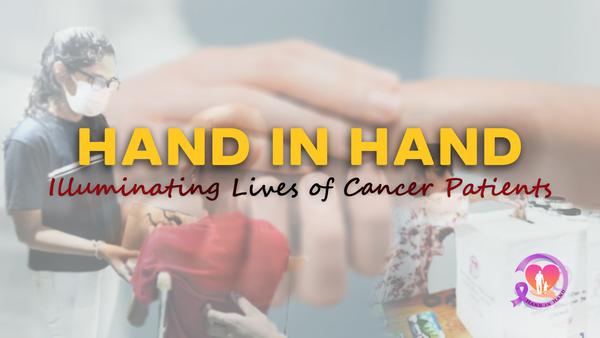Let’s fight against cancer: Types of Cancer - Childhood Cancer
Cancer is a leading cause of death for children and adolescents around the world and approximately 300000 children aged 0-19 years old are diagnosed with cancer each year.
-World Health Organization-
Children can get cancer in the same parts of the body as adults. The difference is, unlike adults, cancer can occur suddenly without any early symptoms in the case of children. However according to American cancer society there are some possible signs and symptoms of cancer in children.
· An unusual lump and swelling
· Unexplained paleness and loss of energy
· Easy bruising or bleeding
· An ongoing pain in one area of the body
· Limping
· Unexplained fever or illness that doesn’t go away
· Frequent headaches, often with vomiting
· Sudden eye or vision changes
· Sudden unexplained weight loss
Special tests have not yet been introduced to detect early-stage cancer in children. Some of the studies and researches show that environmental and lifestyle factors contribute to childhood cancers. Therefore, if proper attention is given to the behavior and lifestyle of children, some childhood cancers can be prevented. On other hand, luckily childhood cancers respond better to certain treatments than adult cancer patients do.
In lower-level income and middle-level income country’s children have chronic infection risk factors like HIV and malaria. These factors increase the risk of childhood cancers. According to the World Health Organization, in high-income level countries, more than 80% of children with cancers are cured, but in lower and middle-level income countries it is only 20%. Inaccurate diagnosis, inaccessible therapy, abandonment of treatments, lack of medical resources, lack of resources and death from toxicity are the reasons for lower survival rate of lower and middle-level income countries. In Sri Lanka around 750 children are newly diagnosed with cancer every year. However, the incidence of cancer is lower in children than in adults.
The most common cancers diagnosed in children are:
1. Leukemia ( cancers of bone marrow and blood)
2. Brain and spinal cord tumors
3. Neuroblastoma ( cancers of nerve cells )
4. Wilms tumor ( cancers of kidneys )
5. Lymphomas ( cancers of lymph nodes or in other lymph tissues
6. Rhabdomyosarcoma ( cancers that start in cells and develop into skeletal muscles )
7. Retinoblastoma ( cancers of the eye )
8. Bone cancers
Childhood cancer awareness ribbon color: Gold
The Gold Ribbon has been used since 1997 as a symbol of childhood cancer because gold is a precious medal. Thus, the Gold Ribbon represents “children”, the most precious thing in our lives.
Childhood cancer awareness month: September
ළමා පිළිකා
ලොව පුරා ළමුන් හා නව යොවුන් වියේ දරුවන්ගේ මරණයට ප්රධානතම හේතුව පිළිකා වන අතර සෑම වසරකම වයස අවුරුදු 0-19 අතර ළමුන් 300000ක් පමණ පිළිකා රෝගයෙන් පෙළෙති.
-ලෝක සෞඛ්ය සංවිධානය-
වැඩිහිටියන්ට මෙන්ම දරුවන්ටද ශරීරයේ ඕනෑම කොටසක පිළිකා වැළඳිය හැකිය. වෙනස නම්, වැඩිහිටියන් මෙන් නොව දරුවන්ගේ පිළිකා කිසිදු මුල් රෝග ලක්ෂණයක් නොමැතිව හදිසියේ ඇතිවිය හැකිය. කෙසේවෙතත් ඇමරිකානු පිළිකා සමාජයට අනුව ළමුන් තුළ පිළිකා ඇතිවිය හැකි සලකුණු හා රෝග ලක්ෂණ තිබේ.
· අසාමාන්ය ගැටිත්තක් සහඉදිමීමක්
· පැහැදිලිකළ නොහැකි සුදුමැලි වීම සහ ශක්තිය නැතිවීම
· පහසුවෙන් තැලීම් හෝ ලේ ගැලීම
· ශරීරයේ එක් ප්රදේශයක අඛණ්ඩ වේදනාවක්
· පැහැදිලි කළ නොහැකි උණ හෝ රෝගී තත්වයන් පහව නොයාම
· බොහෝ විට වමනය සමඟ නිතර නිතර හිසරදය
· හදිසියේ ඇස හෝ පෙනීම වෙනස් වීම
· හදිසියේ පැහැදිලි කළ නොහැකි බර අඩු වීම
ළමුන් තුළ පවතින මුල් අවධියේ පිළිකා හඳුනා ගැනීම සඳහා විශේෂ පරීක්ෂණ තවමත් හඳුන්වා දී නොමැත. සමහර අධ්යයන හා පර්යේෂණවලින් පෙනීයන්නේ ළමා පිළිකා සඳහා පාරිසරික හා ජීවනරටා සාධක හේතු වන බවයි. එමනිසා, වැඩිහිටියන් දරුවන්ගේ හැසිරීම හා ජීවන රටාව කෙරෙහි අවධානය යොමු කරන්නේ නම් සමහර ළමා පිළිකා වළක්වා ගත හැකිය. අනෙක් අතට, වාසනාවකට මෙන් ළමා පිළිකා වැඩිහිටි පිළිකා රෝගීන්ට වඩා ඇතැම් ප්රතිකාර වලට වඩා හොඳ ප්රතිචාර දක්වයි.
පහළ මට්ටමේ ආදායම් සහ මධ්යම මට්ටමේ ආදායම් ලබන රටවල් වල දරුවන්ට එච්.අයි.වී සහ මැලේරියාව වැනි නිදන්ගත ආසාදන අවදානම් සාධක ඇත. මෙම සාධක ළමා පිළිකා ඇතිවීමේ අවදානම වැඩි කරයි. ලෝක සෞඛ්ය සංවිධානයට අනුව, ඉහළ ආදායම් ලබන රටවල පිළිකා ඇති ළමුන්ගෙන් 80% කට වඩා සුවපත් වී ඇති නමුත් පහළ හා මධ්යම මට්ටමේ ආදායම් ලබන රටවල එය 20% ක් පමණි. සාවද්ය රෝග විනිශ්චය, ප්රවේශ කළ නොහැකි ප්රතිකාර, ප්රතිකාර අත්හැරීම, වෛද්ය සම්පත් නොමැතිකම, තාක්ෂණය නොමැතිකම සහ විෂ වීමෙන් මිය යාම පහළ හා මධ්යම මට්ටමේ ආදායම් ලබන රටවල අඩු අනුපාතයට හේතු වේ. ශ්රී ලංකාවේ සෑම වසරකම ළමුන් 750 ක් පමණ අලුතින් පිළිකා රෝගයට ගොදුරු වේ. කෙසේ වෙතත්, පිළිකා ඇතිවීමේ අවදානම වැඩිහිටියන්ට වඩා ළමුන් තුළ අඩුය.
ළමුන් තුළ බහුලව දක්නට ලැබෙන පිළිකා:
1. ලියුකේමියාව(ඇට මිදුළු හා රුධිරයේ පිළිකා)
2. මොළයේහා කොඳු ඇට පෙළේ පිළිකා
3. නියුරෝබ්ලාස්ටෝමා(ස්නායු සෛල වල පිළිකා)
4. විල්ම්ස්(වකුගඩු පිළිකා)
5. ලිම්ෆෝමස්(වසා ගැටිති හෝ වෙනත් වසාපටක වල පිළිකා)
6. රබ්ඩොමියෝසාර්කෝමා(සෛල වලින් ආරම්භ වී අස්ථි මාංශපේශි දක්වා වර්ධනය වන පිළිකා)
7. රෙටිනොබ්ලාස්ටෝමා(ඇසේ පිළිකා)
8. අස්ථිපිළිකා
ළමා පිළිකාපිළිබඳදැනුවත්කිරීමේවර්ණය: රන්
ළමා පිළිකා සංකේතයක් ලෙස 1997 සිට රන් වර්ණය භාවිතා කර ඇත්තේ රන් යනු වටිනා පදක්කමක් වන බැවිනි. රන්වර්ණය අපේ ජීවිතයේ වැදගත්ම දේ “ළමයින්” නියෝජනය කරයි.
ළමා පිළිකා පිළිබඳ දැනුවත් කිරීමේ මාසය: සැප්තැම්බර්
Check out our other blogs on cancer;
1) What is cancer: https://blog.rotaractmora.org/what-is-cancer/
2) What causes cancer: http://blog.rotaractmora.org/causes-of-cancer/
3) Childhood cancer: http://blog.rotaractmora.org/fight-against-cancer/
4) Leukemia: https://blog.rotaractmora.org/hih-cancer-leukemia/
5) Brain cancer: https://blog.rotaractmora.org/brain-cancer/
6) Lung cancer: https://blog.rotaractmora.org/lung-cancer/
7) Breast cancer: https://blog.rotaractmora.org/breast-cancer/
8) Skin cancer: http://blog.rotaractmora.org/skin-cancer/
9) Oral cancer: https://blog.rotaractmora.org/oral-cancer/
10) Thyroid cancer: https://blog.rotaractmora.org/thyroid-cancer-2/
11) Movie review- The fault in our stars: https://blog.rotaractmora.org/movie-review-the-fault-in-our-stars/
12) Cervical cancer: http://blog.rotaractmora.org/cervical-cancer/
13) Colorectal cancer: http://blog.rotaractmora.org/colorectal-cancer/
14) Movie review: My life without me: http://blog.rotaractmora.org/moviereviewmylifewithoutme/
15) Cancer health policy of WHO: http://blog.rotaractmora.org/health-policy-of-who/



